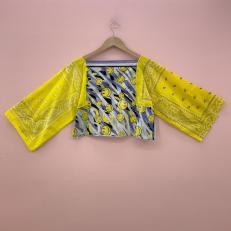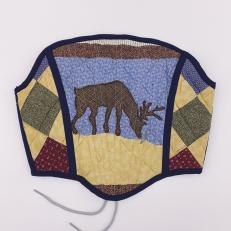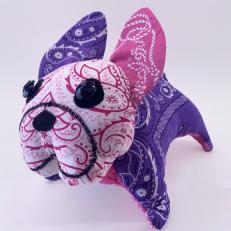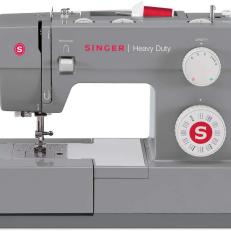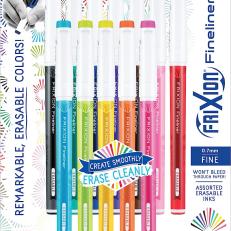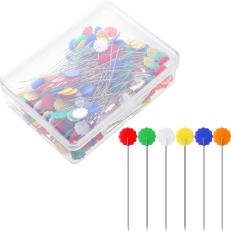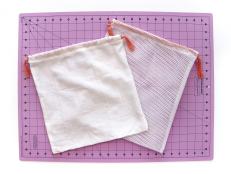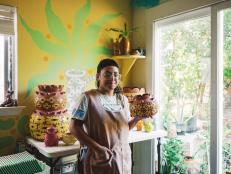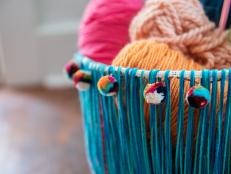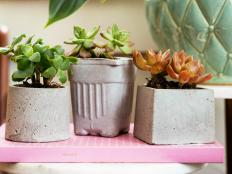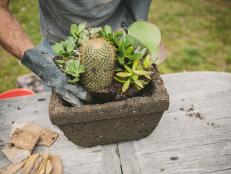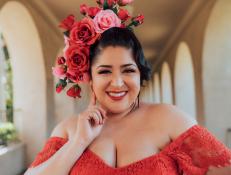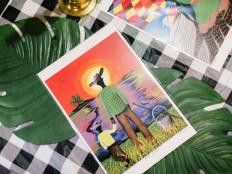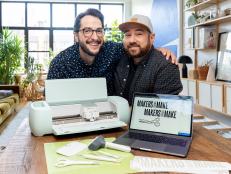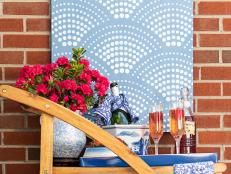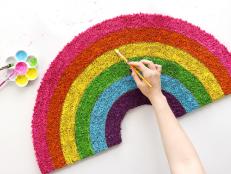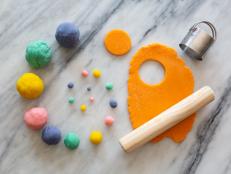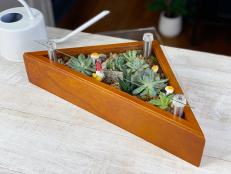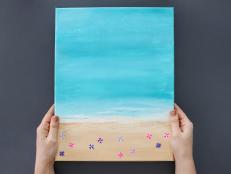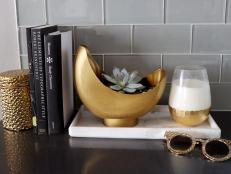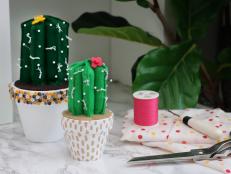Meet the Austin-Based Clothier Who Upcycles Vintage Quilts and Fabrics Into Custom Clothing
Nothing goes to waste at Psychic Outlaw. Rebecca Wright has turned quilts and other abandoned fabrics destined for the landfill into jackets, pants, overalls, hoodies, two-piece short-and-halter sets and more. Explore her studio, plus learn how to turn a thrifted, baggy shirt into a crop top.

Roy Muyinza

Rebecca Wright started sewing in high school simply so she could make her own clothes. She’s a thrift shopper from way back — her first pieces include a romper made from a giant floral sweater and a capelet she made from an oversized sweatshirt.
She had big plans to work in costuming, but then Psychic Outlaw took on a life of its own and became her full-time gig in 2019. Much like her high school days, Rebecca still goes thrift shopping to source vintage fabric and quilts for her upcycling projects.
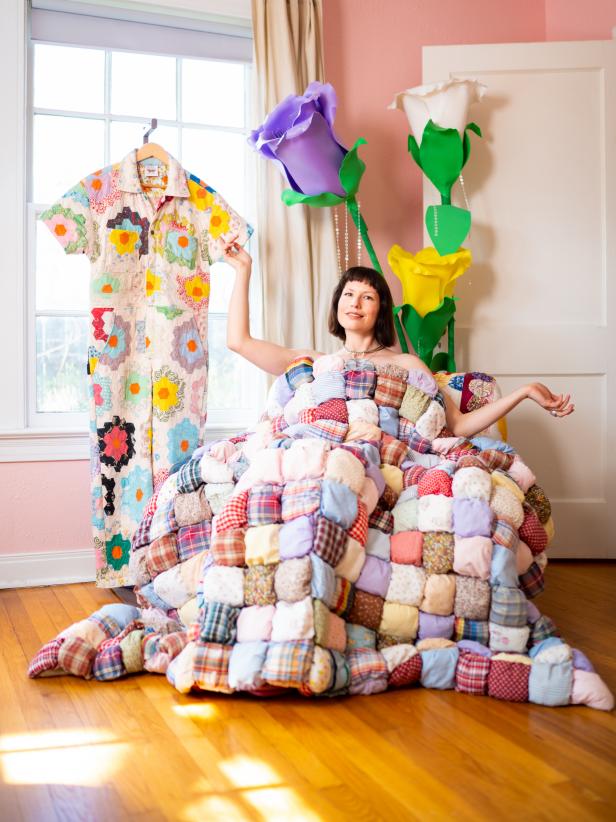
Roy Muyinza
Rebecca really respects the time and skill it takes to create a quilt, and all of the quilts she uses were destined for the landfill before Rebecca rescued them. Some of the quilts may be torn in one area or have a stain, but she works to use everything she can from the quilt.
“I would rather rescue that textile and turn it into something really wearable and continue that history,” she explained.
Quilts are traditionally made of three layers — the top, the batting (an inside filling layer) and the backing. Rebecca does her best to leave all the layers intact as she creates new clothes. Occasionally, she will have just a quilt top to work with. In that case, the team adds a liner into the garment to cover the raw fabric edges.
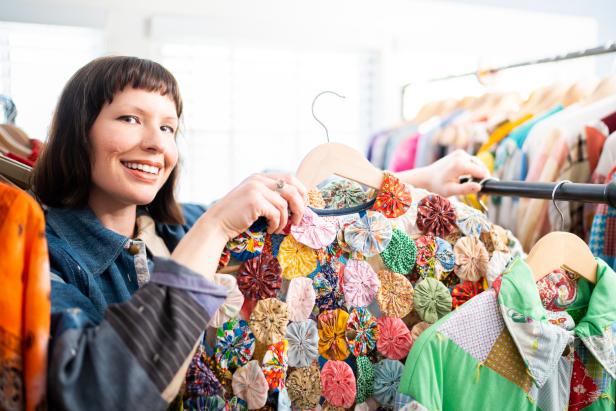
Roy Muyinza
Psychic Outlaw’s studio is a cute home in Austin, Texas, with lots of natural light.
“I tried out an office space for us previously, and it just did not match our cozy homemade vibe at all. We feel safe and happy making things in a cute little house tucked away in a neighborhood,” she explained.
Her sewing studio has it all — a ready-made inventory room, a cutting room with elevated tables for cutting the pieces to make clothing and the sewing room where the magic happens.
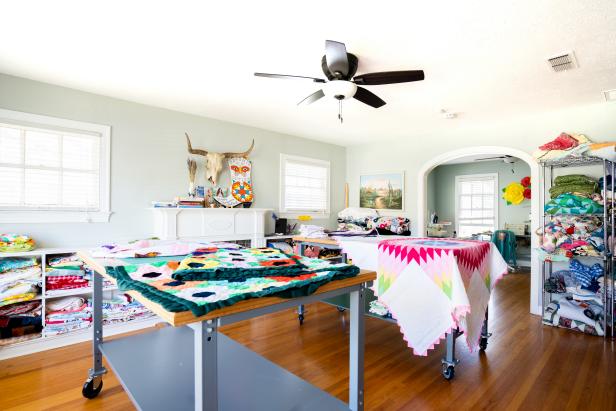
Roy Muyinza
Inside the inventory room, don't miss the bestselling quilt coats or Rebecca's favorite design: the bandana dress. You can also find accessories like zipper pouches and upcycled quilt tote bags. If the inventory on-hand isn't quite what you're looking for, you can supply your own upcycled quilt for Rebecca to turn into one of her custom clothing items.
You can shop Psychic Outlaw designs on their website or see select styles at their Etsy shop. Remember, each Psychic Outlaw piece is completely unique, so if something you want is out of stock, check out the main page for other designs or reach out to Rebecca and her team for a custom piece.
Shop Styles We Love
When Rebecca works, she uses three types of machines — a Babylock serger, a Singer sewing machine and an Econosew industrial sewing machine. Sergers are used to finish the seams in garments, and the industrial sewing machine is a workhorse that can power through the multiple thick layers of fabric as she sews. The regular-sized sewing machine is the same kind used by hobby sewists everywhere — it’s an all-purpose machine with a number of stitch types, widths and lengths for working on a variety of projects.
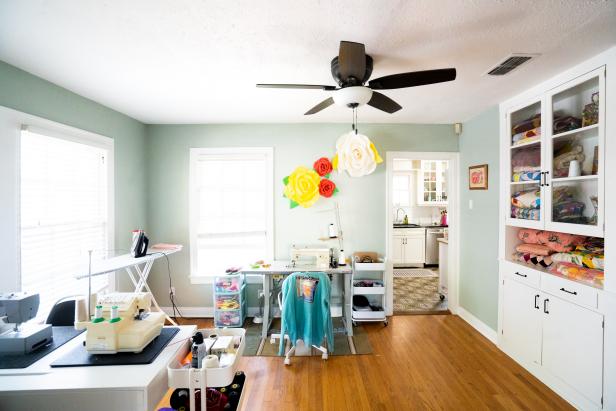
Roy Muyinza
Of course, Rebecca also has a social media room where her photographer, Mikaela Friedman, photographs the clothes and creates all the social media posts. One of the largest pieces in the social media room is the large butterfly backdrop.
“We love to build giant props and things for our pop-ups that we do,” Rebecca said.
Her prop builder is her friend, Zack, who builds wooden frames, and then she and Mikaela upholster them with quilts or other fabric and fill them with scraps as needed. The butterfly, for as large it is, is still the scaled-down version of the original.
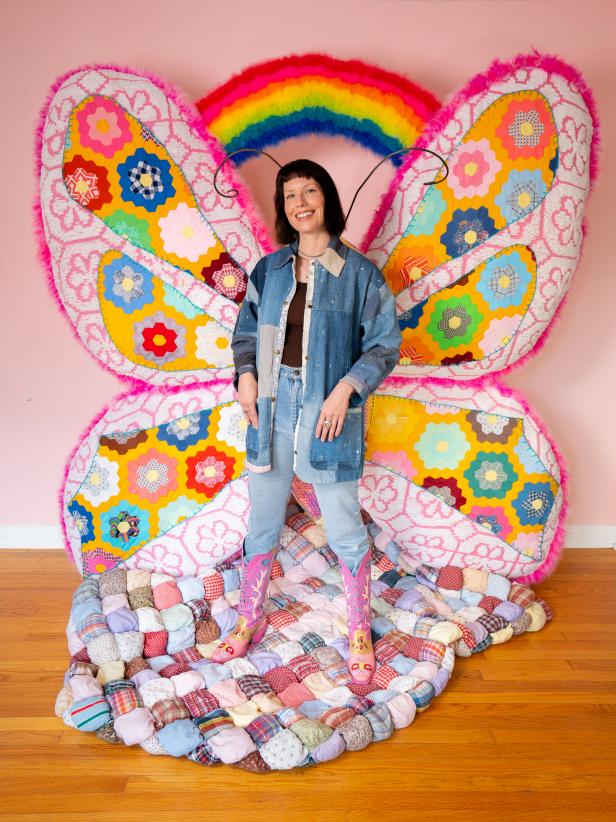
Roy Muyinza
With the help of Zack’s props and Mikaela’s photography skills, Psychic Outlaw has a large social media presence that allows the team to connect with buyers and aspiring textile artists around the globe.
“Even if people aren’t shopping and buying from us, I love that we’re sharing to inspire people.”
Thrift Shop Like Rebecca
In addition to buying discarded and damaged quilts in bulk, Rebecca also makes the rounds at Austin’s best thrift stores to see what she can find.
Treasure City Thrift is a worker’s collective thrift store, meaning each employee is also part owner. Treasure City works to be a no-waste thrift shop that supports marginalized communities and exists for “solidarity, not charity.”
During a recent trip to Treasure City, Rebecca picked up some vintage clothing patterns — they help her learn new-to-her sewing techniques. She also picked up some tapestry-type material in a 1970s-era print, some sequin mesh and a pair of overalls.
Rebecca always checks the lingerie section looking for items made of 100 percent pure silk because it’s a luxurious material and it can be tie-dyed. She thinks of current trends that use vintage looks and makes purchases with projects in mind.
Thrift stores are also a great source for when she needs large amounts of cotton fabric — sheets and blankets can be repurposed and used for unlimited sewing projects.
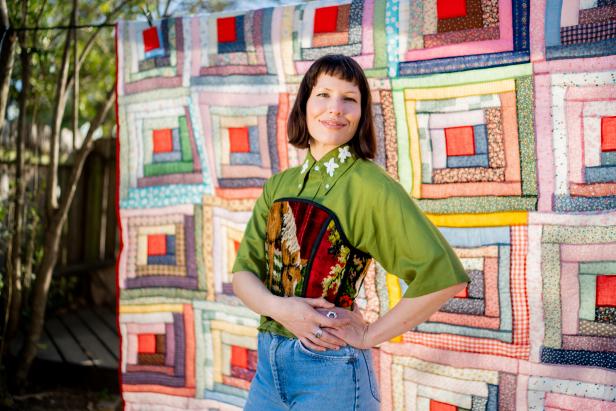
Roy Muyinza
“It really is the most environmental way to buy things,” she said.
For shoppers new to the thrift shopping scene, Rebecca advises starting small at thrift shops that organize their displays so it doesn’t require as much digging to see what’s available. As you get more comfortable with thrifting, branch out and don’t be afraid to get your hands dirty as you hunt for treasures in some of the larger, more chaotic thrift shops.
And one final tip? Don’t forget to look up. Shelves and hangers above eye level are where you can find some of the most unique items. Rebecca recently spotted an authentic leather bag for $30 on a high shelf.
Make Your Own Crop Top

Roy Muyinza
Rebecca found an olive green men’s shirt with a pointed collar and knew immediately she wanted it to be a crop top. Follow these easy instructions for your own DIY crop top made from a thrifted button-down.
Materials + Tools
- men's button down shirt
- scissors
- yardstick or other long ruler
- disappearing fabric pen
- shears
- sewing machine
- thread
- iron
- patches - optional
- straight pins - optional
- seam ripper - optional
Buy the Supplies
Terms to Know:
-
Shears - Fabric or dressmaking shears are extremely sharp scissors that are used only for cutting fabric. Rebecca uses Proshear scissors.
-
Hem - The hem of any fabric item is a finished edge to keep the fabric from unraveling. Hems are generally folded, but some are rolled.
-
Seam - The line along which two or more fabric pieces are joined together
-
Backstitch - Backstitching is done at the beginning and end of a seam to make sure that the threads don’t come apart. It is done by sewing a few stitches, using your sewing machine's reverse lever to sew backward, and then continuing to sew forwards.
-
Straight Stitch - Straight stitches are the most common stitch where the stitches are in a straight line and are the same length across the items to be sewn. Sewing machines allow the user to adjust the length of a straight stitch.
-
Zigzag Stitch - Zigzag stitches can be used to attach patches to items or to do applique. Zigzag stitches can be of varying lengths and widths depending on the allowance of your sewing machine.
1. Measure Yourself
In order to decide how short to cut the shirt, take two measurements. The first measurement is from the top of your shoulder over your chest to where you want the shirt to fall (Image 1). Rebecca prefers a shirt to hit just above her pants. The second measurement starts just below your armpit and continues down to where you want the shirt to fall.
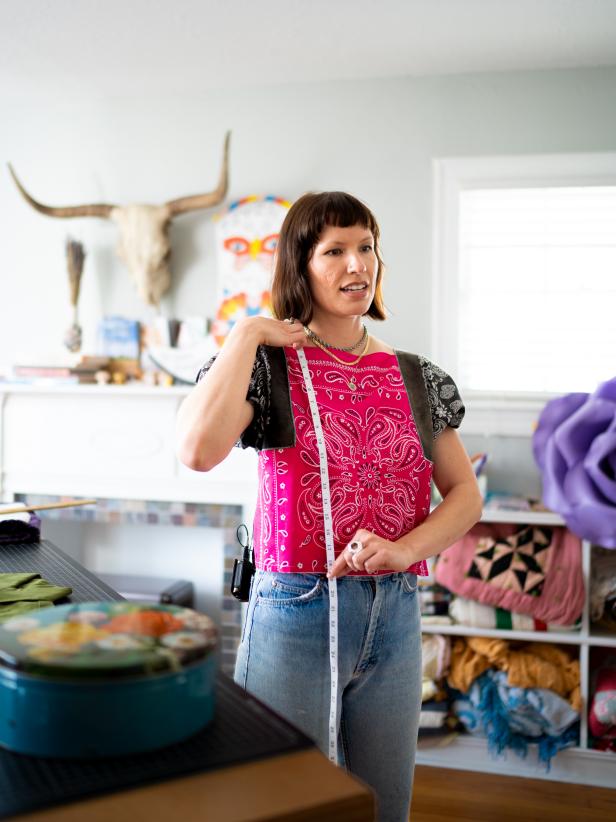
Roy Muyinza
2. Mark the Shirt
Button the shirt and lay it flat on a table. Make sure that it is smoothed as flat as possible so your marks are accurate. Iron it if it’s particularly wrinkly. Next, use a steam pen or water-soluble marker to mark the sides and front of the shirt where you measured to cut (Image 1). Use a yard stick or large ruler to draw a straight line across the shirt through all of your measurement marks.

Roy Muyinza
3. Add the Hem Allowance
The hem will be a half-inch hem folded twice, so draw a second line one inch below your first line (Image 1). The space between the two lines will be folded into the hem you are about to sew.

Roy Muyinza
4. Cut the Shirt
Cut along the second line you drew on the shirt, being careful to keep the bottom arm of the scissors on the table as you cut. This will help keep the shirt layers aligned (Images 1-2). If your line will pass through a button, use a seam ripper to cut the thread holding the button. Rebecca saves all buttons for use in future projects.
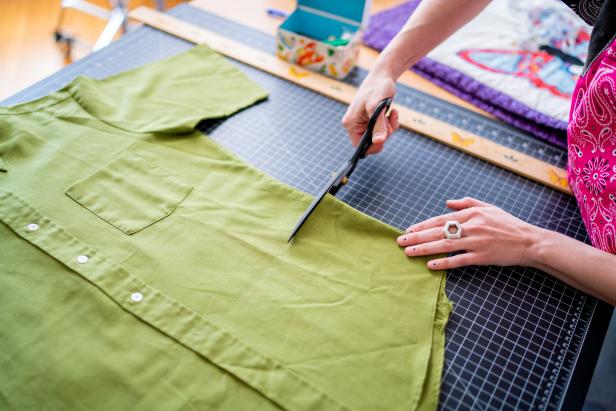
Roy Muyinza
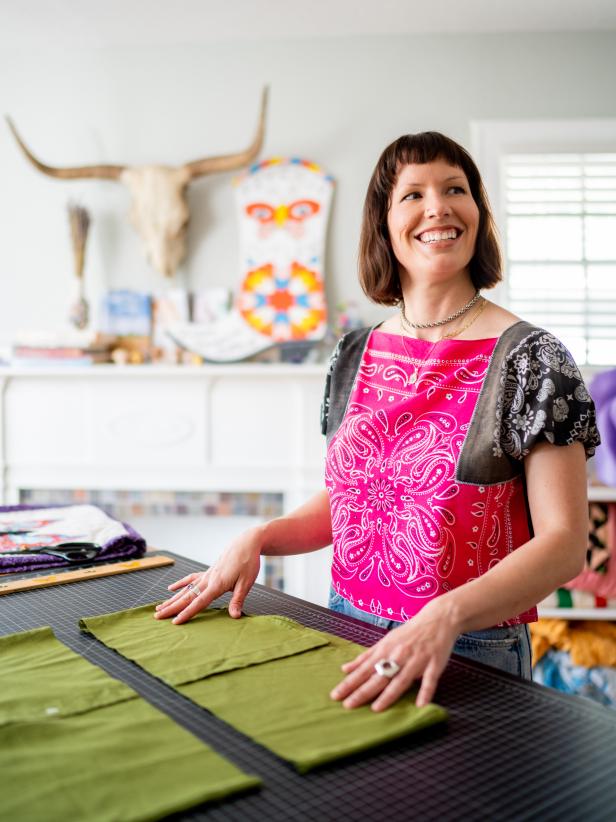
Roy Muyinza
5. Iron the Shirt Hem
This step is what will allow you to set a crisp hemline before sewing it shut. This is where the folded hem is constructed. First, turn the shirt inside out and lay it across your ironing board. Fold the bottom 1/2-inch of the hem up and iron to crease it. The raw edge should be on the inside of the shirt. After you have ironed that, fold the hem up another half inch and press again. The second pressing is what tucks the unfinished edge into the shirt. You can pin the hem as you go if you wish (Image 1).
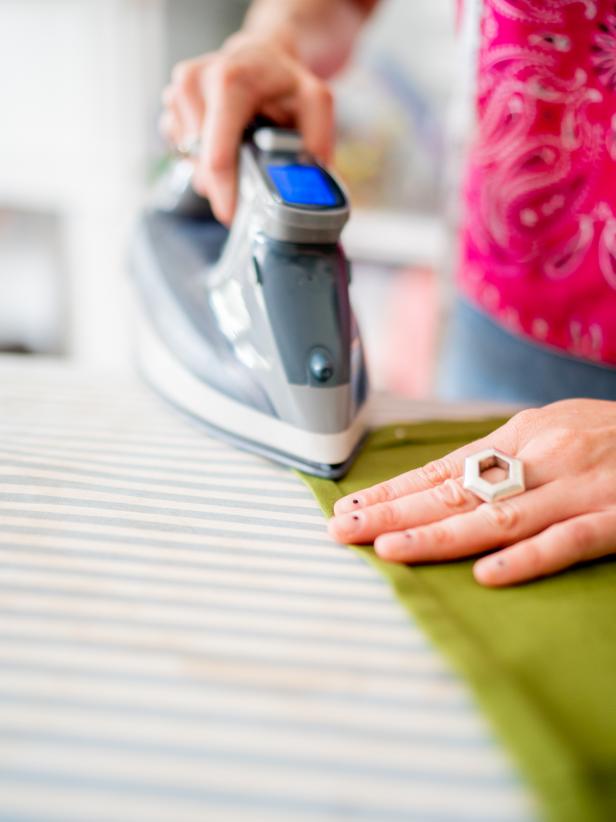
Roy Muyinza
6. Sew the Hem Shut
Keep the roll line facing up as you position the shirt under the needle of your sewing machine. You will sew along the top line of the hem. Sew a few stitches and then backstitch using the reverse lever on your machine. Keep the fold flat as you come all the way across the shirt. Backstitch again at the end and trim the ends (Image 1).

Roy Muyinza
7. Add Patches
This is an optional step, but here’s how to add patches like Rebecca: She found a series of small white flower patches in her tin and decided to add them to the shirt collar. Once you’re happy with the placement of your patches, pin them down and return to the sewing machine (Images 1-2).
Patches can be attached with either a zigzag stitch or a straight stitch. For these, Rebecca used a straight stitch to sew around the edge of the patch. To stay along the outside edge of the patch, leave the needle down, raise your presser foot, and rotate the shirt before lowering the presser foot and continuing to sew. Be sure to backstitch at the beginning and end of each patch (Image 3).
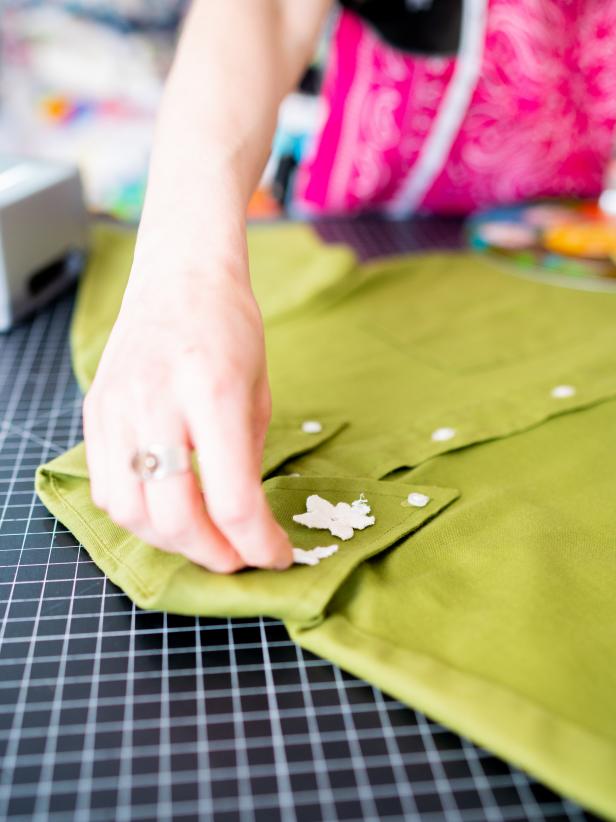
Roy Muyinza
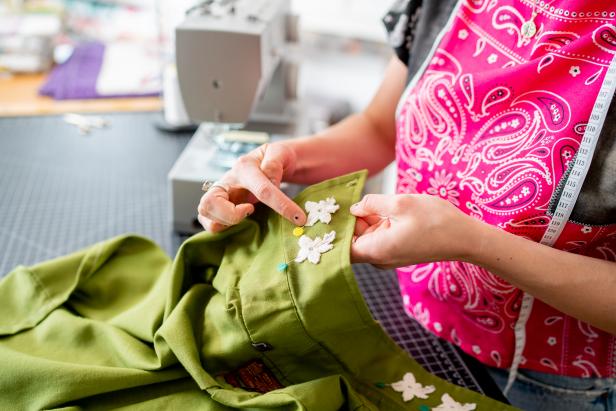
Roy Muyinza
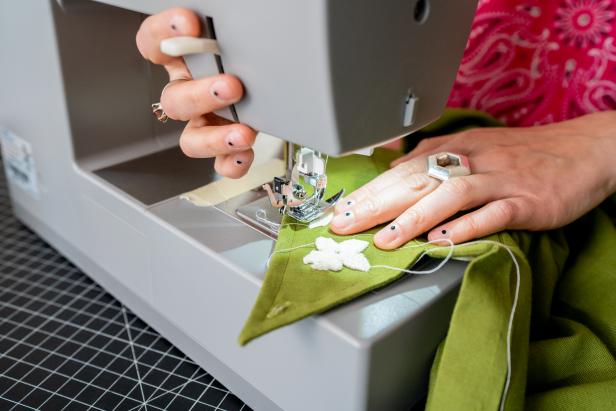
Roy Muyinza
8. Trim the Strings and Wear It
Trim the loose thread ends around the patches, and your DIY crop top is ready to wear (Images 1-2).

Roy Muyinza

Roy Muyinza







